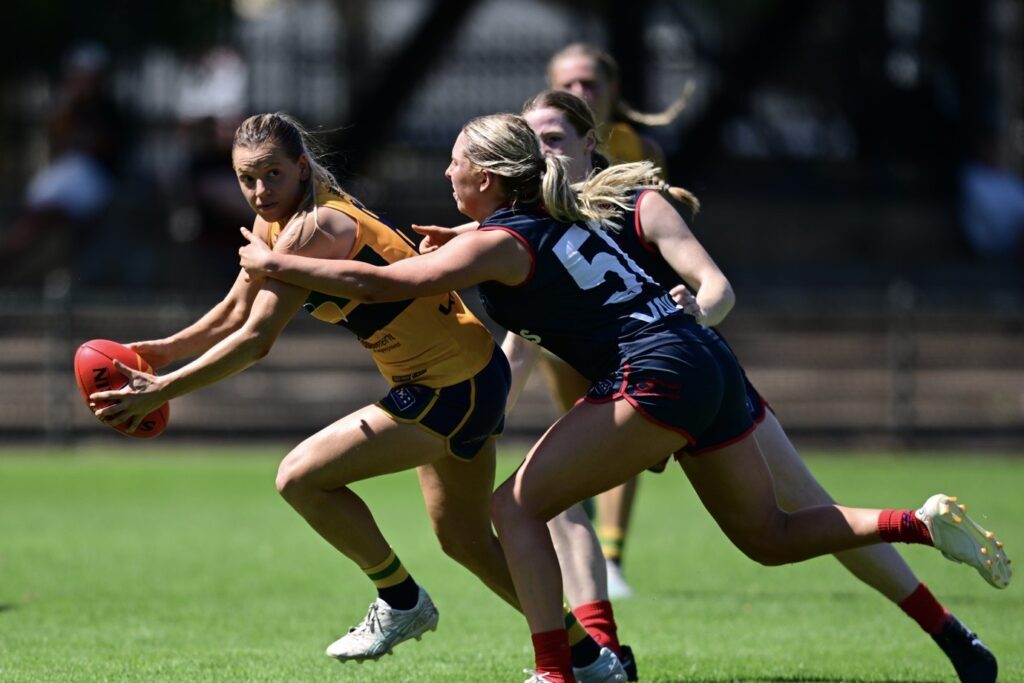Female Australian football players at the sub-elite level experience different injury patterns to their male counterparts, according to new research from the University of South Australia.
Much like elite AFLW athletes, the data shows that South Australian National Football League Women’s (SANFLW) athletes are at greater risk for concussion and ACLs than male athletes in the AFL.
The findings, published in the Journal of Science and Medicine in Sport, highlight a need for targeted training, injury prevention strategies and potential match regulation changes.
Researchers followed 424 players from seven teams in the SANFLW over the course of a season, finding that ankle sprains, concussions and anterior cruciate ligament (ACL) injuries are the most common, and result in the most missed matches.
“Most injury prevention research has been conducted on male athletes, so there’s been a lack of understanding around injury patterns in females,” says Dr Hunter Bennett, UnitSA’s Exercise and Sport Science researcher.
“Understanding the types of injuries that affect female players and how these occur is key to developing targeted strategies to avoid them.”
Some of the increased risk SANFLW players face could be the result of physical differences compared to male athletes, such as greater joint laxity, or less access to consistent and rigorous Australian football training for women.
“There should be a focus on neck muscle training to reduce the incidence of whiplash concussion, lower limb neuromuscular control interventions to prevent ACL injuries, and tackling technique training to reduce the overall amount of contact injuries,” Dr Bennett says.
Nationally and internationally, female sport often has less funding to implement injury prevention strategies.
Contact time between players is also a factor, as the research shows 75 per cent of injuries in SANFLW players resulted due to contact between players. Female Australian football has more tackles per-minute of match play than male Australian football.
Co-author and Senior Lecturer in Human Movement Dr Samuel Chalmers says that female Australian football matches exhibit a different game style, which could be contributing to increased injuries.
“Female Australian football games are more congested than male games, meaning players contextually do less high-speed running,” Dr Chalmers says.
“The congestion contributes to the high rate of contact injuries. Injury prevention strategies that focus on tackling, falling, and landing techniques, as well as implementing rule changes, could mitigate this and reduce injuries.”
Preventing injuries for women in sport
Research has consistently shown that injury prevention for women and girls in sport is lacking.
Data by Yale Medicine– that first started being recorded in the 1990s– has shown female football players are between two and ten times more likely to suffer an ACL injury than their male counterparts.
In one of the more high profile examples of an ACL injury disruption, Matildas superstar Sam Kerr sustained a devastating knee injury that has ruled her out of the Paris 2024 Olympics. The 30-year-old Chelsea striker ruptured her anterior cruciate ligament (ACL).
Meanwhile, last year’s FIFA Women’s World Cup saw at least 25 players sidelined due to the devastating knee injury.
The differences in male and female bodies can have significant impacts when it comes to sporting injuries, including anatomical, biomechanical, physiological and hormonal factors, according to Lyz Evans from Women in Focus Physiotherapy and Health, a female-centred physiotherapy clinic in Sydney.
A hormonal example is that research has shown there are higher rates of ACL injuries in women just before and after menstruation.
“The female body is not simply a smaller version of a male body,” Evans said, echoing calls from many in the sport science space to focus greater injury prevention efforts toward female athletes.



